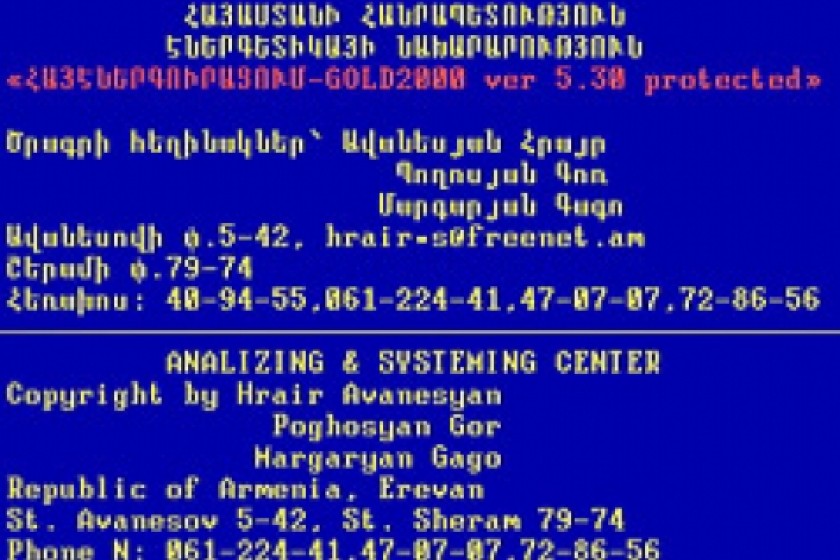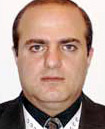
A Programmer Seeks Ownership Rights
It all started towards the end of 2002, when the government sold the Armenian Electric Networks (AEN) company to a foreign enterprise called Midland Resources Holding and Yevgeny Gladunchik became the executive director of the company.
Hrayr Avanesyan, who had worked for the electric networks system since 1996, was relieved of his job at the AEN computer center in January 2003. But that was the continuation of an argument that had arisen much earlier. It all began as follows.
Back in 1996-1997, Avanesyan was working -along with Gor Poghosyan and Gagik Margaryan-on a software package called Gold, which calculated the flow and cost of electricity. The package was completed in June 1997. The program allowed computers to calculate electricity consumption, thus removing the human factor, which had until then permitted many irregularities on the part of both consumers and electricians.
After completing the job, the programmers signed a contract wherein 88 percent of the copyright belonged to Hrayr Avanesyan. At that time, he worked for the Yerevan Electric Network (YEN). But according to Avanesyan, the program had been written outside of working hours and did not have anything to do with his regular job at the YEN. At the same time, the program could not remain on paper alone. Therefore, he presented it to YEN chief director Robert Nazaryan, who agreed to test the program in various YEN branches. In 1998, the Ministry of Energy studied Gold, comparing it with three other programs, and decided to use Avanesyan's product in electricity networks throughout the country. The main competitor to this program had been Abacus, a package imported from abroad.
Gold was supposed to be introduced in three stages, and the author was to receive 3,000 dollars for each stage, or a total of 9,000 dollars. However, during a phone call with the Ministry, Avanesyan learned that the authorities could not reject Abacus completely, because computer hardware was being imported to
 Nevertheless, Avanesyan had signed a contract for the usage of Gold and corresponding technical support with Yerevan Electric Networks and three other state companies operating in Armenia (all four where then merged under AEN and sold by the government), which in essence allowed these organizations - which operated under the jurisdiction of the Ministry of Energy - to use the program he had written with his friends.
Nevertheless, Avanesyan had signed a contract for the usage of Gold and corresponding technical support with Yerevan Electric Networks and three other state companies operating in Armenia (all four where then merged under AEN and sold by the government), which in essence allowed these organizations - which operated under the jurisdiction of the Ministry of Energy - to use the program he had written with his friends.
On November 1, 2002, AEN came under the ownership of Midland Resources Holding. This company run by Yevgeny Gladunchik has been using Avanesyan's Gold program from December 1, 2002 to this day without payment or the agreement of the author. Moreover, in January 2003, Gladunchik signed an order relieving then director of the computer center Avanesyan of his job. The reason was an argument that arose between them. According to Avanesyan, Gladunchik had rudely accused him during a conversation of creating obstacles to the installation of Abacus into the system. They then had a verbal agreement that AEN would complete the introduction of Abacus over a period of 6 months, during which time it would use Avanesyan's Gold without payment. But if Abacus could not be introduced over this period of time, then the company would either rent Gold or buy it. The installation of Abacus failed, but Gladunchik continued to use Avanesyan's program without signing a contract with him.
In August 2004, Avanesyan wrote to Yevgeny Gladunchik and suggested that he either sign a contract to rent the program or stop using it. Gladunchik did not acknowledge Avanesyan's intellectual rights to the program in his reply. In 2007, Avanesyan went to court, asking for his 88 percent of the copyright to be acknowledged and for the company to stop the illegal use and modification of the program.
He based his claim on the 1996 Armenian law regarding copyrights and other applicable rights, since his copyright to the Gold program was given in 1997, when this law was still in force. According to this law, "a copyright arises when a piece of intellectual property is created, irrespective of its official patenting, registration or other formal considerations." According to the same law, "the person noted as the author of the piece when it is first released is recognized as the author, unless proven otherwise by the court." Neither the Ministry of Energy nor Gladunchik's AEN ever went to court to dispute Avanesyan's claim of authorship on the program written in 1997.
 Avanesyan's claim contains an important point, which proves his right to the intellectual property, "The names of the authors of Gold and their permission to use the program are noted in the program and can be seen on the computer screen." In addition to this, Hrayr Avanesyan, Gor Poghosyan and Gagik Margaryan registered their authorship of the program with an NGO called Hayheghinak (Armenian Author) and there were no complaints made through the courts or any other means.
Avanesyan's claim contains an important point, which proves his right to the intellectual property, "The names of the authors of Gold and their permission to use the program are noted in the program and can be seen on the computer screen." In addition to this, Hrayr Avanesyan, Gor Poghosyan and Gagik Margaryan registered their authorship of the program with an NGO called Hayheghinak (Armenian Author) and there were no complaints made through the courts or any other means.
But AEN has refuted Avanesyan's claims, saying that since he worked for YEN at the time, and later for AEN, he was simply fulfilling the obligations of his job. The program was allegedly ordered by the employer and under the Civil Code of Armenia "the employer is considered the legal owner of absolutely all copyrights." AEN noted that Avanesyan never signed a contract regarding the copyright to the program. Therefore, he had fulfilled a work assignment.
On September 5, 2007, the Kentron and Nork Marash Court of First Instance (Judge E. Avetisyan presiding) rejected Avanesyan's claim. The verdict was based on the objections raised by the Armenian Electric Networks, which were copied out in sections. The court decision made no mention of the registration of authorship at Hayheghinak, or the names of the authors within the program itself, visible on the computer screen. Although the court has considered it proven that Avanesyan never signed a written contract for the usage of the program, it also never received a written or verbal confirmation from the company of the fact that it was a work assignment. For some reason, the court was surprised by the fact that Avanesyan suggested signing a contract for the usage of the program he authored only in 2004, which Gladunchik refused to do. Avanesyan reacted to that surprise in his claim for appeal, noting that this was because of certain officials' desire to conceal the failed introduction of Abacus.
However, on October 22, the Court of Appeals (Judge D. Khachatryan presiding) in turn rejected the claim, repeating the verdict reached by the court of first instance.
Hrayr Avanesyan filed a new claim against the Armenian Electric Networks. The latter refused to pay around 590,000 drams in salary debts to the sacked employee (despite repeated oral requests by Avanesyan). Avanesyan asked the court to force the company to pay the debt and around 425,000 drams in interest, as calculated by Central Bank rates, in accordance with the Armenian Civil Code charge of "withholding others' money illegally, avoiding payment in order to put to other use, transfer or keep in another person's account without any legal basis for doing so." The company announced in court that it had not withheld money illegally, but that salaries were given in cash or through transfers, but since the employee had not come to claim it, there was no question of paying any interest. He said that the salary itself was ready for Avanesyan to pick up at the company. Judge Avetisyan upheld the claim as far as the salary was concerned, but rejected the part regarding the interest. However, in reality, as mentioned by Hrayr Avanesyan in his filed appeal, the company owed him 1.2 million drams in January 2003 when he was relieved of his job and he had then received only around 650,000 drams. He had received this money at the company itself. The accounting department had given him papers regarding this amount as well as the remaining debt of 590,000 drams. So how could the company say that he had not claimed his salary after leaving his position? The company simply illegally refused to pay that amount, and there was therefore the right to claim the accumulated interest.
Hrayr Avanesyan is ready to knock on all doors to have his rights acknowledged, including going to the
 Videos
Videos Photos
Photos




Write a comment